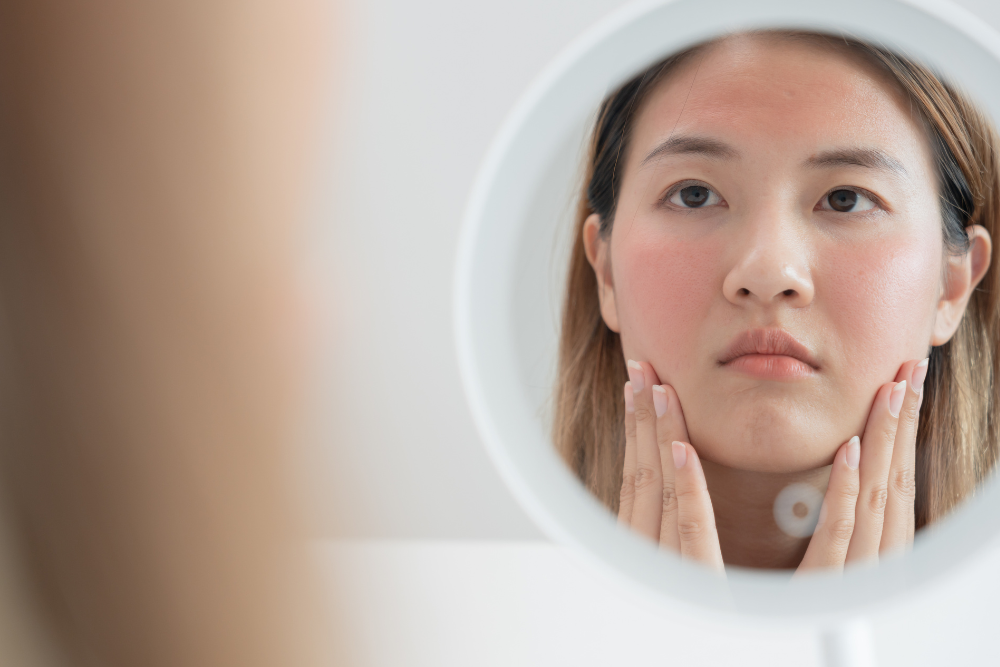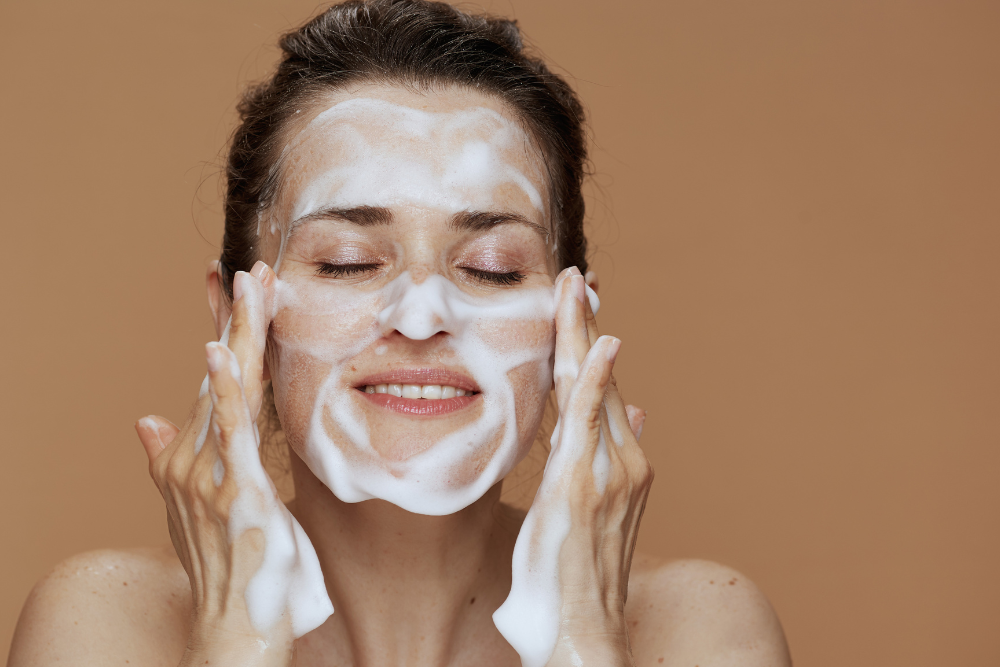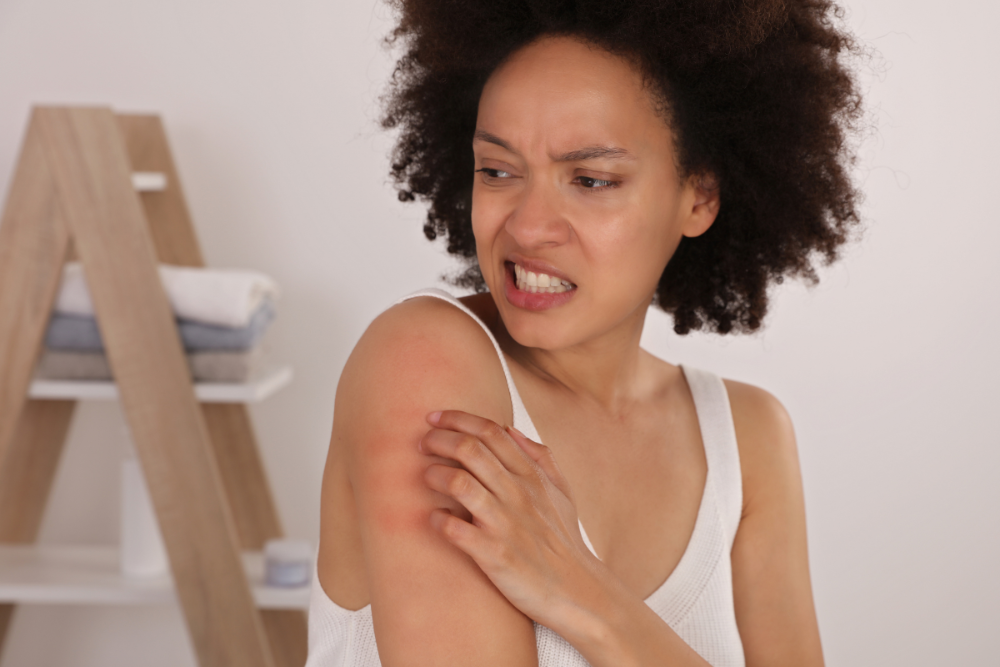Are you tired of dealing with the persistent skin redness and discomfort caused by rosacea? Rosacea can be a challenging condition to manage, but the good news is that there are effective ways to get rid of rosacea permanently. In this guide, we explore practical and sustainable methods to help you bid farewell to rosacea once and for all.
Unlock clear, radiant skin as we delve into actionable steps and lifestyle changes contributing to long-term rosacea relief. Whether you’re a newcomer seeking answers or someone who has battled rosacea for years, our guide is designed to provide you with valuable insights.
Get ready to discover a holistic approach that combines skincare, diet, and lifestyle adjustments, ensuring you not only treat the symptoms but address the root causes of rosacea. Say goodbye to temporary fixes and hello to a life without the daily struggle against redness and irritation.
Understanding Rosacea: Causes and Symptoms
Causes of Rosacea
Genetic Predisposition
While the precise cause of rosacea remains elusive, research indicates a strong genetic component. If someone in your family has experienced rosacea, you may be genetically predisposed to developing the condition. Understanding your family history can provide valuable insights into your susceptibility.
Environmental Triggers
Rosacea often reacts to external stimuli, making it important to identify and manage environmental triggers. Exposure to sunlight, extreme temperatures, and wind can exacerbate symptoms. By recognising these triggers and taking proactive measures to protect your skin, you can significantly reduce the frequency and intensity of rosacea flare-ups.
Demodex Mites
Microscopic organisms called Demodex folliculorum inhabit facial skin and hair follicles. Research suggests that an overabundance of these mites may contribute to inflammation, triggering rosacea symptoms. Maintaining good skin care practices and considering targeted rosacea treatments can help keep Demodex populations in check.
Vascular Abnormalities
Abnormalities in blood vessels, especially those near the skin’s surface, are associated with rosacea. These vessels may dilate excessively, leading to persistent redness and visible blood vessels. Understanding the vascular component of rosacea is essential for developing effective treatment strategies that address the root cause.

Symptoms of Rosacea
Now that we’ve explored some potential causes, let’s turn our attention to the distinctive symptoms that characterise the skin condition known as rosacea.
Persistent Facial Redness
One of the hallmark symptoms of rosacea is a persistent skin redness on the central face, including the cheeks, nose, forehead, and chin. Rosacea redness may resemble a flush or sunburn and can be exacerbated by triggers like heat or stress. Luckily, there are ways to manage stress that may help.
Dry, Thickened Skin
In rosacea, dry and thickened skin is common due to a weakened skin barrier. Using gentle skincare helps soothe dryness and enhance skin health.
Visible Blood Vessels
In some cases, tiny blood vessels near the skin’s surface become visible, contributing to the overall redness. These dilated blood vessels, known as telangiectasia, are a common manifestation of rosacea.
Papules and Pustules
In cases of severe rosacea, it can cause red bumps (papules) and pus-filled pimples (pustules) on the face that resemble acne. These lesions may be accompanied by a sensation of heat or burning.
Eye Irritation
Ocular rosacea can affect the eyes, causing redness, dryness, and a gritty sensation. If left untreated, it may lead to more severe eye problems.
Understanding these causes and symptoms lays the foundation for effective rosacea management. In the following sections, we explore targeted approaches and lifestyle changes to address these factors and work towards achieving long-lasting relief.

Effective Skincare Routine for Rosacea Relief
While there is no permanent cure for rosacea, the skin condition can be managed and controlled with a good skincare routine.
Step 1: Gentle Cleansing – Use a mild cleanser: Start with a gentle, soap-free cleanser to wash your face. Look for one that’s kind to sensitive skin and doesn’t have harsh chemicals or fragrances.
Step 2: Soothing Toner – Apply a calming toner: After cleansing, use a toner with ingredients like aloe vera or chamomile to soothe your skin. This helps prepare your skin for the next steps and reduces redness.
Step 3: Prescription Treatment – Consult your dermatologist: If prescribed by your dermatologist, incorporate a prescription treatment for rosacea. Follow their instructions carefully and use it as part of your routine.
Step 4: Moisturise Gently – Choose a sensitive skin moisturiser: Opt for a moisturiser designed for sensitive skin to keep your face hydrated without causing irritation. Look for ingredients like glycerin or hyaluronic acid.
Step 5: Sunscreen – Protect with SPF: Finish your routine with sunscreen. Use a broad-spectrum SPF 30 or higher to shield your skin from the sun, a common trigger for rosacea flare-ups.
Remember, everyone’s skin is different, so it’s essential to consult your dermatologist to find the right routine for you. These simple steps can help manage rosacea symptoms and keep your skin feeling its best.

Dietary Adjustments for Managing Rosacea
Your dietary choices can play a significant role in managing rosacea symptoms and promoting skin health from within. While individual triggers may vary, certain general guidelines can help you make informed decisions about what you eat.
Firstly, consider incorporating anti-inflammatory foods into your diet, such as fatty fish rich in omega-3 fatty acids, colourful fruits and vegetables, and whole grains. These foods can help reduce inflammation associated with rosacea.
In contrast, limit or avoid potential triggers that may exacerbate symptoms. Common culprits include spicy foods, hot beverages, alcohol, and certain histamine-rich foods. Some individuals find that dairy and high-glycemic foods can also contribute to flare-ups. Keeping a food diary and noting any changes in your skin’s response can help you identify specific triggers.
Remember, personalised dietary adjustments may be necessary, so consulting a healthcare professional or a registered dietitian can provide tailored guidance based on your unique needs and sensitivities. Making thoughtful dietary adjustments can complement your skincare routine and contribute to the holistic management of rosacea.

Natural Remedies for Calming Rosacea Flare-ups
Managing rosacea flare-ups doesn’t always require complex solutions. Here are simple and natural remedies that may help soothe your skin and treat rosacea during those sensitive moments:
1. Cool Compresses: Applying a cool compress to your face can help reduce redness and ease the sensation of heat during a flare-up. Use a clean cloth soaked in cold water and gently press it against your skin for a few minutes.
2. Green Tea Soaks: Green tea is known for its anti-inflammatory properties. Brew a cup of green tea, let it cool, and then use a cotton pad to apply it to your face. The antioxidants in green tea may help calm irritation.
3. Aloe Vera Gel: The cooling effect of aloe vera can be beneficial for rosacea-prone skin. Apply a thin layer of pure aloe vera gel to affected areas to help reduce inflammation and soothe discomfort.
4. Oatmeal Masks: Create a gentle mask by mixing finely ground oatmeal with water to form a paste. Apply it to your face for 10-15 minutes, then rinse with cool water. Oatmeal has anti-inflammatory properties that may provide relief.
5. Essential Oils (Diluted): Certain essential oils, such as chamomile or lavender, when properly diluted with a carrier oil, may offer soothing effects. Conduct a patch test before using them on your face, and consult with a dermatologist to ensure compatibility with your skin.
6. Stress Reduction Techniques: Stress is a known trigger for rosacea flare-ups. Engage in relaxation techniques such as deep breathing, meditation, or yoga to help manage stress levels and potentially reduce the frequency of flare-ups.
Always be cautious and perform patch tests before applying any new remedy to your face. Also, consult your dermatologist before incorporating natural remedies, especially if you have allergies or sensitivities. While these natural approaches can provide relief for some individuals, it’s essential to personalise your approach based on your skin’s needs.

Daily Habits to Prevent Rosacea Recurrence
Consistent daily habits can play a big role in preventing the recurrence of rosacea flare-ups. By incorporating these simple practices into your routine, you can maintain healthier skin and reduce the likelihood of experiencing skin redness and irritation:
1. Gentle Skincare Routine: Stick to a mild skincare routine using products designed for sensitive skin. Avoid harsh scrubs and abrasive cleansers that can trigger irritation. Consistency in your routine can help keep your skin in balance.
2. Sun Protection: Shield your skin from the sun’s harmful rays by applying a broad-spectrum sunscreen daily. Opt for at least SPF 30 and reapply throughout the day, especially if you spend extended periods outdoors.
3. Temperature Awareness: Extreme temperatures can trigger rosacea flare-ups. Be mindful of hot weather, and use a humidifier in dry, cold conditions to maintain a comfortable environment for your skin.
4. Identify and Avoid Triggers: Keep track of potential triggers such as spicy foods, hot beverages, or stressful situations. Understanding what sets off your rosacea can empower you to make informed choices that support your skin health.
5. Hydration: Stay well-hydrated by drinking plenty of water throughout the day. Proper hydration supports overall skin health and can contribute to a reduction in redness and inflammation.
6. Stress Management: Practice stress reduction techniques, such as meditation or deep breathing exercises, to minimise emotional and physical stressors. Stress is a common trigger for rosacea, so finding effective coping mechanisms is beneficial.
7. Maintain a Healthy Diet: Incorporate anti-inflammatory foods into your diet, such as fruits, vegetables, and fatty fish. Limit or avoid potential triggers like spicy foods, alcohol, and high-glycemic foods.
8. Gentle Exercise: Engage in moderate, low-impact exercises such as walking or swimming. Avoid strenuous activities that may lead to excessive sweating, as sweat can be a trigger for some individuals. Check out tips for staying motivated to exercise.
Integrating these daily habits into your lifestyle can create a supportive environment for your skin, reducing the likelihood of rosacea recurrence. Consistency is key, and personalised adjustments may be necessary based on your triggers and skin response.

Embracing Confidence with Rosacea: Makeup Tips
Having rosacea doesn’t mean sacrificing the joy of makeup or feeling less confident. In fact, a strategic makeup application can enhance your features while minimising the appearance of redness. Start with a gentle, hydrating primer to create a smooth canvas. Opt for a green-tinted colour corrector to neutralise red tones, applying it sparingly on affected areas.
Choose a fragrance-free, non-comedogenic foundation that provides ample coverage without irritating your skin. Mineral-based foundations can be a good choice as they are often gentle and offer buildable coverage. Concealers can work wonders for specific spots, and a yellow-toned concealer can counteract redness effectively.
Steer clear of powder formulations, as they may exacerbate dryness. Instead, use cream blushes and eyeshadows to add a natural flush to your complexion. Finish with a setting spray to lock in your makeup without drying out your skin. Remember, makeup is a tool to enhance your beauty, and with the right techniques and products, you can confidently showcase your radiant self while managing rosacea with flair.

Overcoming Rosacea with Professional Treatments
While effective skincare routines and lifestyle adjustments can significantly manage rosacea, professional rosacea treatment prescribed by a dermatologist offers targeted solutions for more severe cases. One powerful option is prescription skincare, featuring ingredients with strengths not readily available in over-the-counter products. Dermatologists may recommend prescription creams or gels containing ingredients like azelaic acid to address inflammation and reduce redness.
These prescription-strength treatments provide a higher concentration of active ingredients, offering a more potent response to rosacea symptoms. These treatment options are carefully tailored to an individual’s skin needs and are often a key component in a comprehensive approach to managing rosacea. Consulting with a dermatologist allows for a personalised assessment of your condition, leading to a treatment plan that may include professional interventions to complement your daily skincare routine. Embracing these advanced solutions can be a transformative step towards achieving lasting relief from rosacea.




